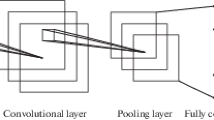Abstract
Convolutional neural network (CNN) has more and more applications in image recognition. However, the structure of CNN is often determined after a performance comparison among the CNNs with different structures, which impedes the further development of CNN. In this paper, an adaptive convolutional neural network (ACNN) is proposed, which can determine the structure of CNN without performance comparison. The final structure of ACNN is determined by automatic expansion according to performance requirement. First, the network is initialized by a one-branch structure. The system average error and recognition rate of the training samples are set to control the expansion of the structure of CNN. That is to say, the network is extended by global expansion until the system average error meets the requirement and when the system average error is satisfied, the local network is expanded until the recognition rate meets the requirement. Finally, the structure of CNN is determined automatically. Besides, the incremental learning for new samples can be achieved by adding new branches while keeping the original network unchanged. The experiment results of face recognition on ORL face database show that there is a better tradeoff between the consumption of training time and the recognition rate in ACNN.









Similar content being viewed by others
References
LeCun Y, Boser B, Denker JS et al (1989) Backpropagation applied to handwritten zip code recognition. Neural Comput 1(4):541–551
Nebauer C (1998) Evaluation of convolutional neural networks for visual recognition. IEEE Trans Neural Netw 9(4):685–696
Garcia C, Delakis M (2002) A neural architecture for fast and robust face detection 2002. In: Proceedings 16th international conference on pattern recognition, IEEE, vol 2, pp 44–47
Krizhevsky A, Sutskever I, Hinton GE (2012) Imagenet classification with deep convolutional neural networks. Advances in neural information processing systems, pp 1097–1105
Farabet C, Martini B, Akselrod P, et al. (2010) Hardware accelerated convolutional neural networks for synthetic vision systems. In: Proceedings of 2010 IEEE international symposium on circuits and systems (ISCAS) IEEE, pp 257–260
Peemen M, Setio AAA, Mesman B, et al. (2013) Memory-centric accelerator design for convolutional neural networks. In: IEEE 31st International conference on computer design (ICCD), IEEE, 2013, pp 13–19
Strigl D, Kofler K, Podlipnig S (2010) Performance and scalability of GPU-based convolutional neural networks. In: 18th Euromicro international conference on parallel, distributed and network-based processing (PDP), IEEE, 2010, pp 317–324
Cheung B, Sable C (2011) Hybrid evolution of convolutional networks. In: 10th International conference on machine learning and applications and workshops (ICMLA), IEEE, 2011, vol 1, pp 293–297
Wu C, Fan W, He Y, et al. (2012) Cascaded heterogeneous convolutional neural networks for handwritten digit recognition. In: 21st International conference on pattern recognition (ICPR), IEEE, 2012, pp 657–660
Sermanet P, LeCun Y (2011) Traffic sign recognition with multi-scale convolutional networks. In: The 2011 international joint conference on neural networks (IJCNN), IEEE, pp 2809–2813
Chen X, Xiang S, Liu CL et al (2014) Vehicle detection in satellite images by hybrid deep convolutional neural networks. IEEE Geosci Remote Sens Lett 11(10):1797–1801
Gu JL, Peng HJ (2009) Incremental convolution neural network and its application in face detection. J Syst Simul 21(8):2441–2445
Saito J H, de Carvalho T V, Hirakuri M, et al. (2005) Using CMU PIE human face database to a convolutional neural network-neocognitron. ESANN. pp 491–496
Acknowledgments
Project supported by the Nature Science Foundation of Shandong Province (No. ZR2014FM012, and No. ZR2014YL010), the Shandong Science and Technology Development Program (No. 2012GSF12004).
Author information
Authors and Affiliations
Corresponding author
Rights and permissions
About this article
Cite this article
Zhang, Y., Zhao, D., Sun, J. et al. Adaptive Convolutional Neural Network and Its Application in Face Recognition. Neural Process Lett 43, 389–399 (2016). https://doi.org/10.1007/s11063-015-9420-y
Published:
Issue Date:
DOI: https://doi.org/10.1007/s11063-015-9420-y




